The Surface 3 Review
by Brett Howse on May 4, 2015 9:00 AM ESTSystem Performance
Since the Surface 3 is a tablet that can replace your laptop, comparisons will be made between both devices. Because the new tablet is running full Windows 8.1 x64, it is possible to run the full benchmark suite that we have for laptops. On the tablet side, there are not a lot of cross-platform benchmarks so the only thing that can really be used is browser based tests. It is not ideal, but we have to work with what we have.
To summarize the Surface 3, it is powered by the top model of the latest Intel Atom 14nm stack. The Atom x7-Z8700 is a quad-core processor with a base frequency of 1.6 GHz. The CPU can turbo up to a maximum of 2.4 GHz, and all of this is done within a 2 watt Scenario Design Power. The review unit that I received is the $499 unit, so it only has 2 GB of LPDDR3 memory rather than the 4 GB offered on the higher priced model.
For comparisons against tablets, I have selected a sampling of several devices that have already been reviewed. Some of the devices are running on ARM processors, and several of the Windows ones run on Intel Core M, with a few more running on previous Atom architectures. To compare this device against any other device we have tested, please check out our Mobile Bench.
Tablet Performance
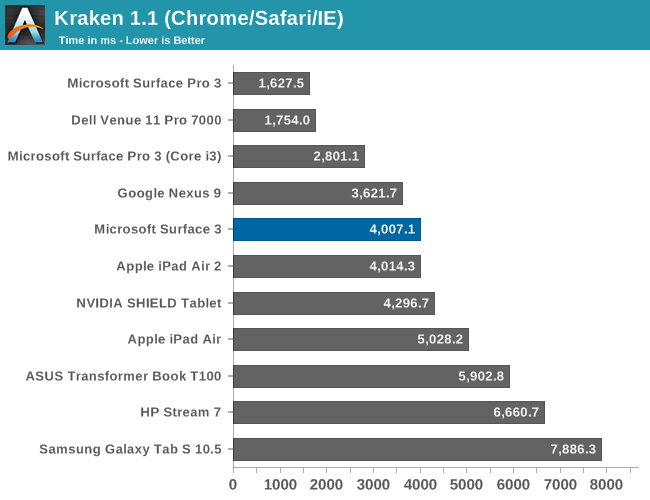
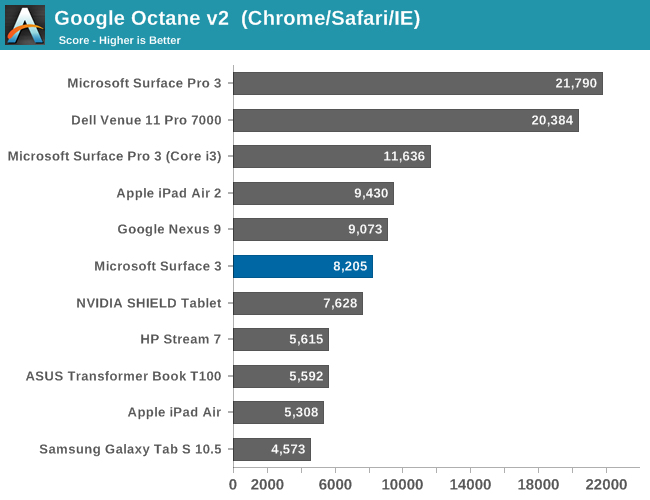

Since we just have web benchmarks to compare against other platforms, it does make it difficult to get a true feel for how Atom compares to the best, but when comparing to ARM processors it is fairly competitive. All of the web benchmarks are done using Chrome (hopefully we can switch to Microsoft Edge soon) because IE 11 has pretty awful javascript performance. Atom is a long ways off of the Core series in the Surface Pro line, and well back of the Core M powered Dell Venue 11 Pro tablet. There is a big jump in performance compared to the Bay Trail ASUS T100 and HP Stream 7. That is important since Cherry Trail is not a big architecture update, but mostly a process shrink, so the 14 nm processes can keep everything running at higher frequencies in the same power envelope.
Laptop Performance
By attaching the keyboard, the Surface 3 becomes a pretty reasonable laptop, so to see how much of a performance drop off there is with tablet class parts, the Surface 3 was run through our Laptop suite as well. The Atom is also equipped with eMMC storage, and some of the tests like PCMark take storage into account. Other benchmarks like Cinebench and x264 are CPU only. To compare the Surface 3 against any other laptop we have tested, please use our Laptop Bench.
PCMark

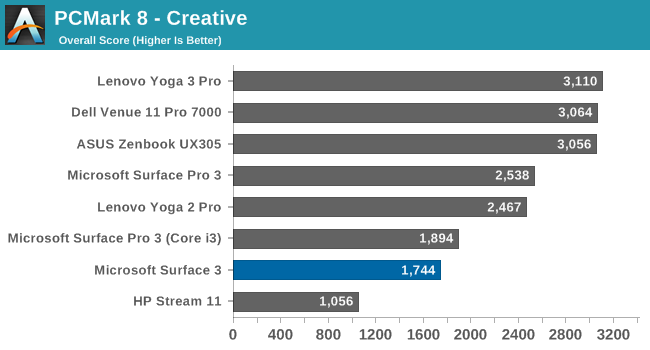
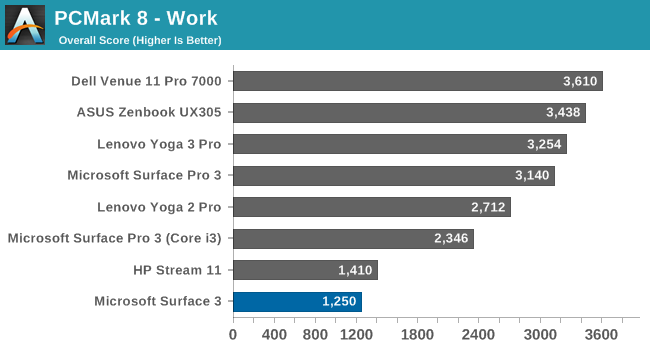
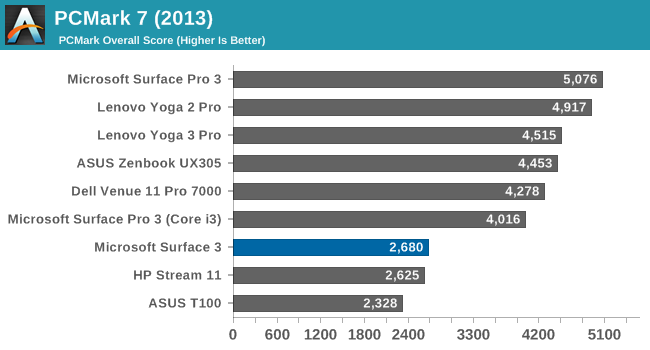
PCMark 8 from Futuremark has several benchmarks within it, all with the goal of simulating real-world use cases for each of the scenarios. It includes Home, Creative, Work, and Storage benchmarks. The workloads generally include both burst and sustained performance. The Atom can’t compete with the bigger Core pieces, but it is actually surprisingly close to the Core i3 Surface Pro 3. I think this is less about Atom and more about how handicapped Core i3 is with its lack of Turbo.
TouchXPRT


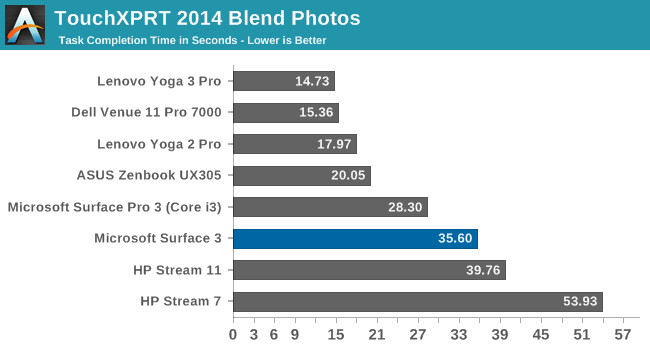
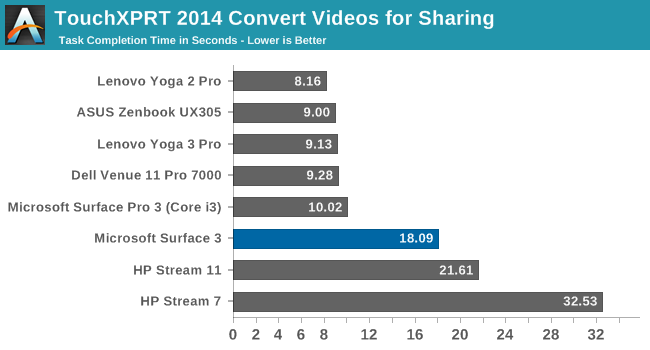
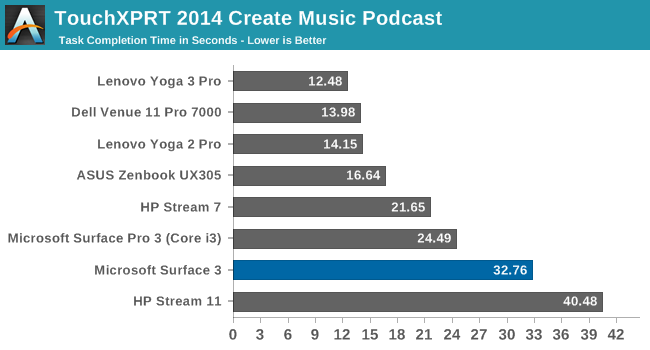
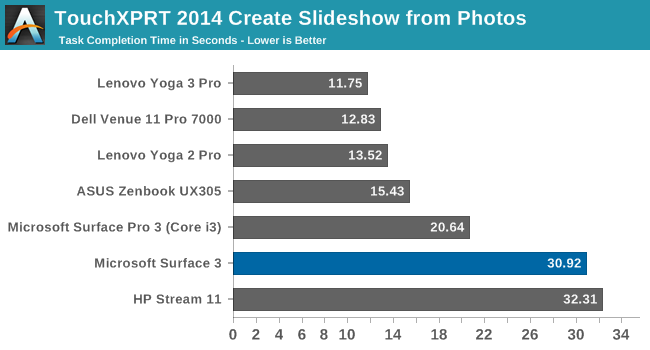
TouchXPRT 2014 is a benchmark that has a lot of burst workloads. The tasks are quick, but heavy, and it gives the processor a quick chance to cool off between each one so normally it is good about not running into throttling behaviour. The Atom processor is a long way off of the Core series here, with the exception of the i3 Surface Pro 3 which has no turbo capability. However there is a good bump in performance over the previous generation Atom in the HP Stream 7.
Cinebench

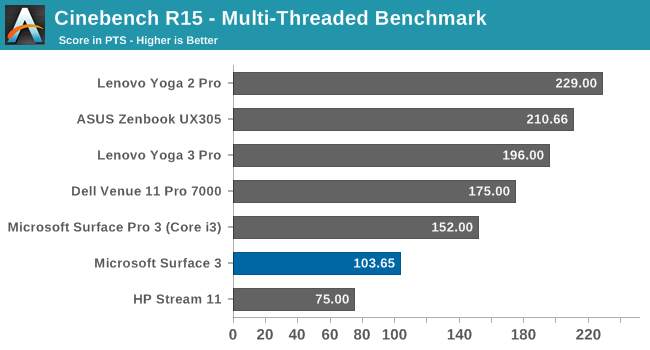
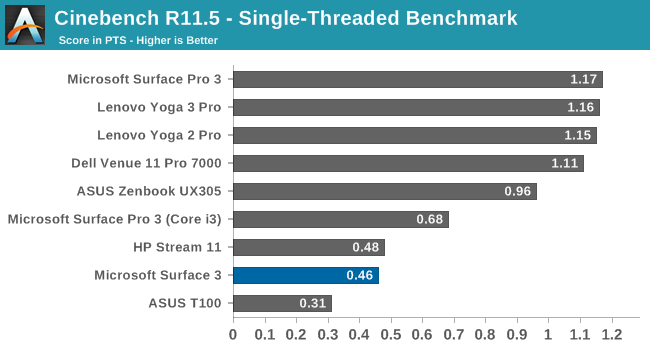
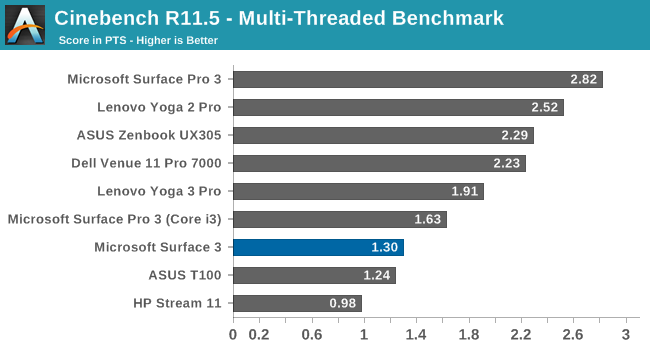
Cinebench is purely a CPU task, and it loves Instructions Per Clock (IPC) and frequency. There are two modes here with a single CPU run and all core run. It is still a long ways back of the Core i3 Surface Pro 3 on this test, and despite the Atom processor having four physical cores and the Core processors having only two physical and four logical cores, it is still not enough on the multithreaded run to really close the gap, although it does slightly. Looking at version 11.5 of this test, we have more data going back to older devices, so there are scores available from the ASUS T100 and there is a bump in performance compared to Bay Trail.
x264
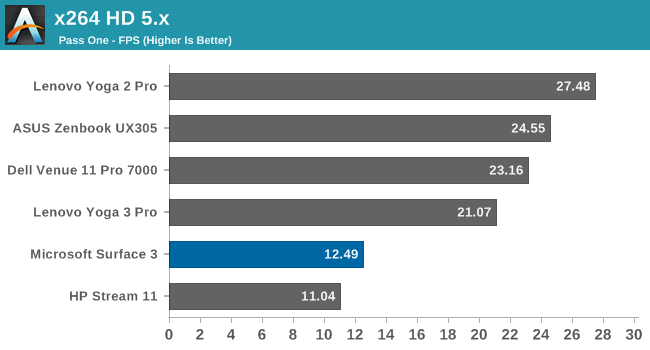

Once again this is a benchmark that prioritizes good IPC and frequency, along with multiple cores. The Atom struggles here compared to Core, which at this point should not be a surprise.
So clearly the new Cherry Trail CPU cores are not a giant leap in performance over Bay Trail, but like Haswell to Broadwell, there is a decent bump and the better manufacturing process helps increase overall performance due to the additional thermal headroom in the same power envelope. However when comparing it to the ARM competition, we only have a few data points but it does seem to be about on par with the top ARM CPUs at this time. Comparing devices across different operating systems is always difficult though.
Using the device day to day as a tablet though, performance was good. Yes, it could be better, and devices that use Core M are going to be able to run circles around Atom, but at the cost of additional heat. One of the nicest surprises of using this tablet was that it just never got warm at all, and the same cannot be said of any of the passively cooled Core M devices. Sure, when running very heavy benchmark loads, there was a bit of heat on the back, but it was never much more than around 30°C or so.
My experience was that when the Surface 3 felt slow, it was often not CPU bound but disk bound.










265 Comments
View All Comments
bobjones32 - Monday, May 4, 2015 - link
Well, what's your definition of "strong"?If the Surface Pro 3's main competitor is the MacBook Air, then that should be the sales benchmark, not tablets. Apple sold around 4.5 million Macs in total for its most recent quarter - so that includes all Airs, Pros, desktops, etc.
If as you math'd Microsoft sold ~700k Surface Pro 3s, that seems pretty good compared to the record-highest number that Apple has ever sold of all Macs put together, considering that the SP3 still isn't sold in as many countries, is still a relatively new entry, and has the public taint of Windows 8 on it.
Speedfriend - Tuesday, May 5, 2015 - link
Strong is a correct description.In the Dec quarter Surface sold over 1m units versus the 1.5m-2m MacBook airs that Apple sold in the quarter. I would call that a fantastic performance.
In the last quarter Surface revenue grew 46%, versus Mac revenue growing 2% and iPOAd revenue falling a staggering 28%. Again I would call that a fantastic performance!
For a product that Microsoft is forced to price at a premium (or risk alienating its OEM cusotmers even more), it is selling exceptionally well.
jhoff80 - Monday, May 4, 2015 - link
Yes, the charging connector on past Surface devices has been finicky (though I've never used a Surface 2 or Pro 3 myself), but with the design of Microsoft's charging cords all keeping the cord parallel with the device, I couldn't imagine being limited to a non-reversible connector like this one is.Depending on how I'm sitting/positioning the Surface Pro 2 on my lap or desk, sometimes cord up is far more convenient and sometimes cord down is. Not having that choice would be a huge pain with this cord design, and so I'm a little surprised that Microsoft didn't at least change away from that sort of design with microUSB as their connector.
chizow - Monday, May 4, 2015 - link
Nice review Brett, great background info for those that were unaware of the evolution the Surface non-Pro has undergone. I was initially optimistic about the Surface RT, but once I found out its limitations I was one of the many that asked for an Atom-based x86 replacement to fill in that low-end gap to bring Surface's great design and interface to the masses.Now that we have it, it is certainly a nice device but I don't feel the price point is low enough, nor the performance good enough, to wow the masses. We will see, but it doesn't look like Cherry Trail was much of an advancement over previous Bay Trail, which is coming up on 2 years old. Maybe if MS included the Stylus (a net minus over the Pro) and/or the type pad, it would be a better deal, but with the various specials and incentives Microsoft typically offers even on new Surface parts, there is hope for this part yet.
Michael Bay - Wednesday, May 6, 2015 - link
2W for SoC on x86 is not an advancement for you?shodanshok - Monday, May 4, 2015 - link
A question about connected standby and hibernation: Microsoft's documentation state that hibernation is entered only with critically low battery level (and this level is configurable using the advanced power settings). This match my experience on two different Win8.1 tablets (HP Stream 7 and Dell Venue 11 Pro 7000).On the other hand, on your review you stated that Surface 3 enter hibernate after "some hours" of idling in connected standby.
Is the Surface 3 behaving differently than other Win8.1 tablets (and from Microsoft own documentation?)
LINK: https://msdn.microsoft.com/en-us/library/windows/h...
Brett Howse - Monday, May 4, 2015 - link
Here you go: https://support.microsoft.com/en-us/kb/2998588/lilmoe - Monday, May 4, 2015 - link
how long does it take to resume from hibernation? <5 seconds? 5-10? >10?shodanshok - Tuesday, May 5, 2015 - link
So it was a custom power profile from Microsoft. Very interesting to know...Thank you ;)
mva5580 - Monday, May 4, 2015 - link
The Web Browsing battery test is baffling to me. How can it possibly be LESS than a SP3? Atom processor, smaller screen, lower resolution. I don't get that one at all.